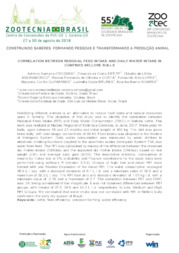Correlation between residual feed intake and daily water intake in confined nellore bulls.
Correlation between residual feed intake and daily water intake in confined nellore bulls.
Author(s): CROZARA, A. S.; EIFERT, E. da C.; MAGNABOSCO, C. de U.; COSTA, M. F. O. e; LOPES, F. B.; GUIMARÃES, N. C.; BRUNES, L. C.; SOARES, B. B.
Summary: Identifying efficient animals is an alternative to reduce food costs and natural resources used in farming. The objective of this study was to identify the correlation between Residual Feed intake (RFI) and Daily Water Consumption (DWC) in Nellore cattle. The work was realized at Núcleo Regional of Embrapa Cerrados, in June, 2017. Were used 44 bulls, aged between 18 and 21 months and initial weight of 455 kg. The diet was given twice daily, with corn silage: concentrate of 60:40. Feed intake was obtained in the feeders of Intergado System. Daily water consumption was measured by water drinked in electronic drinking fountains coupled to the automatic scales (Intergado System TM) plus water from feed. The RFI was calculated by means of the difference between the observed dry matter intake (DMIobs) and the expected dry matter intake (DMIexp) based on live weight (LW) and average daily gain (ADG). The descriptive statistics, comparison of means by Tukey test at 5% probability and Pearson correlations for the study traits were performed using software R (version 3.3.2). Groups of high, low and mean RFI were formed with one Standar Desviation of the mean RFI. The water consumption averaged 38.9 L / day, with a standard deviation of 6.1 L / d, and a minimum value of 30.0 and a maximum of 62.2 L / day. The RFI had zero and standard deviation of 1.01 kg / d, with a minimum value of -2.38 and a maximum of 2.7. The correlation between RFI and DWC was .24, being considered of low magnitude. It was not observed differences between RFI groups, with means of 37.0, 38.8 and 42.3 L / d, respectively, to Low, Medium and High RFI Groups. We concluded that water intake was not correlated with RFI in Nellore bulls confined in the early dry season of Brazil.
Publication year: 2018
Types of publication: Abstract in annals or event proceedings
Unit: Embrapa Cerrados
Keywords: Agricultura de Precisão, Alimento Animal, Bovino, Gado Nelore, Água
Observation
Some of Embrapa's publications are published as ePub files. To read them, use or download one of the following free software options to your computer or mobile device. Android: Google Play Books; IOS: iBooks; Windows and Linux: Calibre.
Access other publications
Access the Agricultural Research Database (BDPA) to consult Embrapa's full library collection and records.
Visit Embrapa Bookstore to purchase books and other publications sold by Embrapa.

